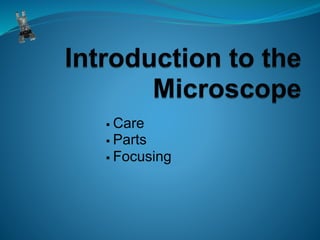
microscope
- 1. Care Parts Focusing
- 2. Types of Microscopes Light Microscope - the models found in most schools, use compound lenses to magnify objects. The lenses bend or refract light to make the object beneath them appear closer. Common magnifications: 40x, 100x, 400x
- 3. The Light Microscope Guidelines for Use • Always carry with 2 hands • Only use lens paper for cleaning • Do not force knobs • Always store covered
- 4. Eyepiece Body Tube Revolving Nosepiece Arm Objective Lens Stage Stage Clips Coarse Focus Fine Focus Base Diaphragm Light
- 5. Magnification Your microscope has 3 magnifications: Scanning, Low and High. Each objective will have written the magnification. In addition to this, the ocular lens (eyepiece) has a magnification. The total magnification is the ocular x objective
- 6. General Procedures 1. Make sure all backpacks and materials are out of the aisles and off the tops of desks. 2. Plug your microscope in to the outlet. 3. Store with cord wrapped around microscope and the scanning objective clicked into place. 4. Carry by the base and arm with both hands.
- 7. Focusing Specimens 1. Always start with the scanning objective. Odds are, you will be able to see something on this setting. Use the Coarse Knob to focus and then the fine adjustment knob until clear, image may be small at this magnification, but you won't be able to find it on the higher powers without this first step. Do not use stage clips, try moving the slide around until you find something.
- 8. 2. Once you've focused on Scanning, switch to Low Power. Use the Coarse Adjustment Knob to refocus. Then use the Fine Adjustment Knob to make the image crystal clear. Again, if you haven't focused on this level, you will not be able to move to the next level. 3. Now switch to High Power. (If you have a thick slide, or a slide without a cover, do NOT use the high power objective). At this point, ONLY use the Fine Adjustment Knob to focus specimens. Recap 1. Scanning --> use coarse and fine knob 2. Low power --> use coarse and fine knob 3. High power --> use fine knob only DO NOT SKIP STEPS!!!!
- 9. • Your slide MUST be focused on low power before attempting this step • Click the nosepiece to the longest objective • Do NOT use the Coarse Focusing Knob, this could crack the slide or the lens • Use the Fine Focus Knob to bring the slide
- 10. Drawing Specimens 1. Use pencil - you can erase and shade areas 2. All drawings should include clear and proper labels (and be large enough to view details). Drawings should be labeled with the specimen name and magnification. 3. Labels should be written on the outside of the circle. The circle indicates the viewing field as seen through the eyepiece, specimens should be drawn to scale - ie..if your specimen takes up the whole viewing field, make sure your drawing reflects that.
- 11. Cleanup 1. Store microscopes with the scanning objective in place. 2. Wrap cords and cover microscopes. *Double check to make sure you didn't leave a slide 3. Place microscopes in their designated location (probably a cabinet)
- 12. Troubleshooting Occasionally you may have trouble with working your microscope. Here are some common problems and solutions. 1. Image is too dark! Adjust the diaphragm, make sure your light is on. 2. There's a spot in my viewing field, even when I move the slide the spot stays in the same place! Your lens is dirty. Use lens paper, and only lens paper to carefully clean the objective and ocular lens. The ocular lens can be removed to clean the inside. The spot is probably a spec of dust. 3. I can't see anything under high power! Remember the steps, if you can't focus under scanning and then low power, you won't be able to focus anything under high power. Start at scanning and walk through the steps again. 4. Only half of my viewing field is lit, it looks like there's a half-moon in there! You probably don't have your objective fully clicked into place..
- 13. Practice Labeling the Parts
- 14. Quiz Over the Microscope 1. When focusing a specimen, you should always start with the ___________________ objective. 2. When using the high power objective, only the ________ ___________ knob should be used. 3. The type of microscope used in most science classes is the _________________ microscope 4. What part of the microscope can adjust the amount of light that hits the slide? ______________________________
- 15. 5. You should carry the microscope by the ________ and the __________. 6. The objectives are attached to what part of the microscope (it can be rotated to click the lenses into place): _______________ ________________ 7. You should always store you microscope with the ________________ objective in place. 8. A microscope has an ocular objective of 10x and a high power objective of 50x. What is this microscope's total magnification? ____________
